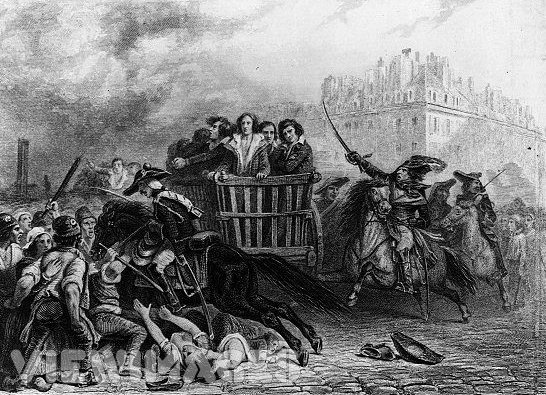
In the 8th district of Paris, not far from St Lazare railway station, is a little-known chapel that survived at least 21 attempts to have it demolished between 1830 and 1914. It became known as La Chapelle Expiatoire, the chapel of atonement[1]. The objections were not to its beauty but to what it meant. It commemorated King Louis XVI and Queen Marie-Antoinette who had been publicly guillotined in 1793. It brought back dark memories, and reproached and unsettled those who applauded the revolution of 1789.
In 1815, Louis and Marie-Antoinette’s only child to survive the revolution, their eldest daughter, Duchesse d’Angoulême, and her uncle, now restored to the throne as Louis XVIII, decided to build this commemorative chapel, which was finally completed in 1826. The King bought the land out of his own money, and he and Duchesse paid for the chapel’s construction. The memorial is restrained, not triumphal.[2]
Today, trees and shrubs in a messy little park break up any coherent view of the building. The monumental entrance, set back from the street, is rather uninviting, the cloistered sides resemble a dilapidated cloister and the rear building, which backs directly on to the street, has neither an entrance nor any hint of what lies inside. Only when you enter do you discover what the writer and statesman François René de Chateaubriand (1768-1848) called ‘perhaps the most remarkable monument in Paris’[3].
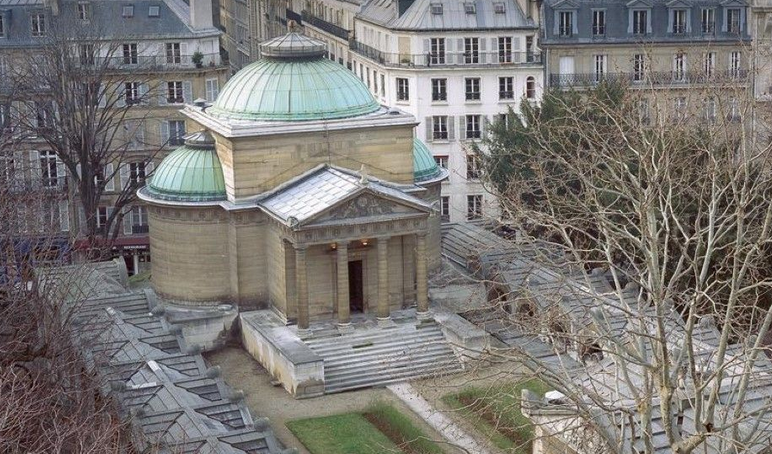
From the entrance hall, you step on to a gravel path flanked by white roses, a lawn and a row of stylised unmarked graves on each side that remember more than 600 Swiss Guards who were killed in defending the king and queen in 1792. The chapel complex and surrounding park rest on the former cemetery of the Madeleine, in which many victims of the revolution, including the king and queen, were buried with little dignity in rough wooden coffins dumped in pits of quicklime. A cloistered passageway on each side encloses the monument from the park. The effect “strikes the imagination and fills it with sadness”[4], Chateaubriand wrote.
The gravel path leads up to a flight of steps to the chapel, designed around a single centralised vertical high point, such as the Pantheon in Rome or Hagia Sophia in Istanbul. This design was generally used in mausoleums, baptisteries and chapels. Natural light enters through openings in the four vaults that make up the domed ceiling. At the far wall directly facing the entrance is the altar. This is a Roman Catholic chapel. The 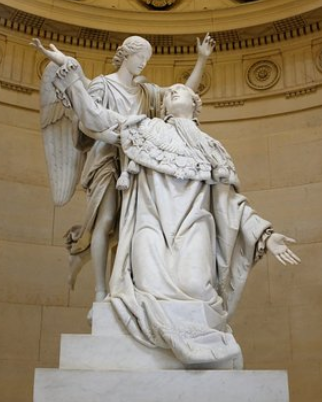 Church had suffered much during the Revolution. It not only lost its privileges but all its property, including its churches. Catholic priests and nuns who refused to renounce their obedience to Rome were executed. ‘Reason’ was idolised in a new cult, which in 1792 celebrated itself with an atheistic ceremony inside Notre Dame.
Church had suffered much during the Revolution. It not only lost its privileges but all its property, including its churches. Catholic priests and nuns who refused to renounce their obedience to Rome were executed. ‘Reason’ was idolised in a new cult, which in 1792 celebrated itself with an atheistic ceremony inside Notre Dame.
To one side of the chapel is a large statue of King Louis supported by an angel (right), with his last will and testament engraved in black marble on the pedestal. The National Convention definitively abolished the monarchy, and acted as the King’s accusers and as his jury. Finding him guilty, it condemned him to death by a margin of just five votes. The revolution was frail, and so the King was too dangerous to remain alive, as Robespierre explained:
In the bosom of a revolution which is held together by nothing but just laws, neither prison nor exile can make [the King’s] existence harmless to public happiness. Louis must die, because the motherland must live[5].
Degraded from the title of ‘King’ to ‘Citizen Capet’, Louis went to his death with dignity. The executioner tied his hands tied behind his back, laid him on the bench beneath the guillotine and cut off his head.
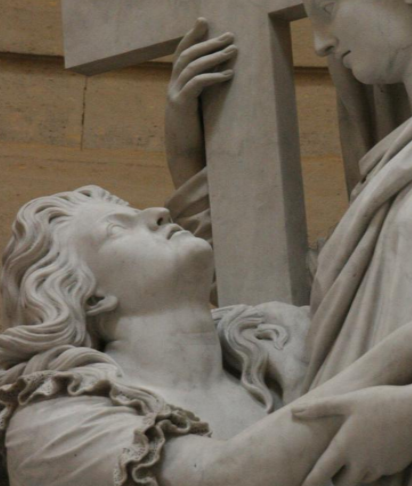 On the other side, another statue (left) shows Marie-Antoinette as she kneels before the figure of Religion, her final consolation. At her show trial, amid gasps from the audience, the prosecutor, among other things, accused her without warning of committing incest with her own son. At first silent, then challenged to reply, she replied:
On the other side, another statue (left) shows Marie-Antoinette as she kneels before the figure of Religion, her final consolation. At her show trial, amid gasps from the audience, the prosecutor, among other things, accused her without warning of committing incest with her own son. At first silent, then challenged to reply, she replied:
If I have not replied, it is because Nature herself refuses to respond to such a charge laid against a mother. I appeal to all mothers who may be here.[6]
Her children had been taken away from her months before. They knew nothing of her fate and could never say good-bye. Her last letter engraved on her pedestal, to her sister, herself executed in 1794, was never delivered. She was taken through the street to her public execution in an open cart. She too died with dignity.
Downstairs is the crypt, a modest altar stands on the place from which the remains King Louis XVI and his wife were exhumed in 1815. Chateaubriand, who was present, later wrote: ’In the midst of the bones, I recognised the Queen’s head by the smile which that head had given me at Versailles.’[7]
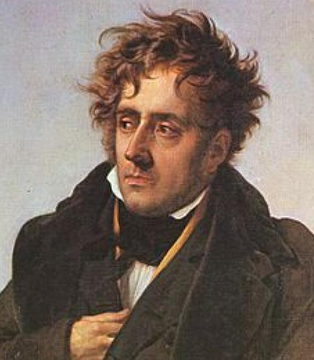 The chapel tells us that King Louis and his Queen were Christian martyrs. Chateaubriand (right), who admired this monument, was also a Royalist. His understanding of the deaths of the King and Queen is unsettling. He saw the beginnings of the Revolution as a 21-year-old, and at first felt some sympathy for its reforms. By 1792, however, he joined Royalist troops fighting against the revolutionaries and was badly injured. He fled as an exile to London, where lived in poverty until 1800 when he returned to France. There he built a reputation as a great writer of fiction and prose. With the defeat of Napoleon, he served as a politician, minister and diplomat under the restored monarchy of Louis XVIII and Charles X. His written works cited here include a long essay on ancient and modern revolutions, an analysis of French history, an influential defence of the faith and moral sense of Christianity and six volumes of posthumously published memoirs. Chateaubriand was convinced that Christian faith and moral virtue were what mattered in human history, not different combinations of political ideas:
The chapel tells us that King Louis and his Queen were Christian martyrs. Chateaubriand (right), who admired this monument, was also a Royalist. His understanding of the deaths of the King and Queen is unsettling. He saw the beginnings of the Revolution as a 21-year-old, and at first felt some sympathy for its reforms. By 1792, however, he joined Royalist troops fighting against the revolutionaries and was badly injured. He fled as an exile to London, where lived in poverty until 1800 when he returned to France. There he built a reputation as a great writer of fiction and prose. With the defeat of Napoleon, he served as a politician, minister and diplomat under the restored monarchy of Louis XVIII and Charles X. His written works cited here include a long essay on ancient and modern revolutions, an analysis of French history, an influential defence of the faith and moral sense of Christianity and six volumes of posthumously published memoirs. Chateaubriand was convinced that Christian faith and moral virtue were what mattered in human history, not different combinations of political ideas:
The moral state of the people is the key which opens the secret book of Fate. Morals make up the centre around which political worlds revolve, and in vain do they seek to distance themselves or else they fall into the unfathomable abyss.[8].
At the bottom of this abyss stood the men of The Terror, those deniers and denied of God[9], who killed the Monarch, nobles, political dissenters and, as is the way with revolutions, eventually each other. In the public squares of Paris, priests and nuns, tradespeople were sent to their deaths in the name of Liberté, égalité, fraternité.
The revolutionaries who most ardently sought the death of the King and Queen rejected Christianity, some rejected even a notion of God. Although their ambition for a new ideology failed, manifested in Robespierre’s invention of a new creed that brought back ‘God’ in 1793 at his Festival of the Supreme Being. It all left a legacy of a radical division between religious faith and politics, known and upheld in France to this day as laïcité [secularism], which rejects the notion that the supernatural must be called upon to legitimate the political order in France, which is founded solely on the sovereignty of the citizen population’[10].
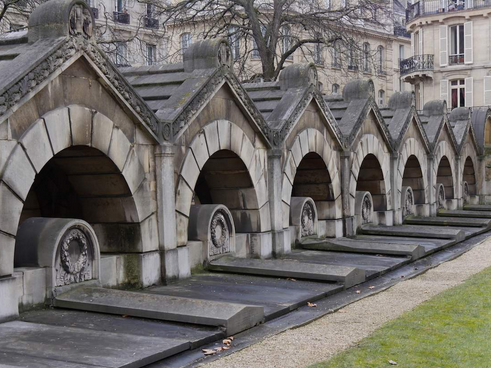
The memorial ‘crypts’ honouring the 600 fallen Swiss Guards.
Though Chateaubriand saw the King and Queen as martyrs, he also believed the King’s execution was a final atonement and reckoning for the absolute monarchy of Louis XIV and the collapse in morals and good government under the next king, Louis XV, writing
The Monarch who initiated us into liberty, Louis XVI, was made to expiate in his own person the despotism of Louis XIV. and the corruption of Louis XV [11].
Indeed, Chateaubriand was explicit:
What deludes us is that we measure the designs of Eternity by the scale of our short life. We pass away so quickly that God’s punishment cannot always fall within the short moment of our existence: the punishment descends when the time comes; it no longer finds the original culprit, but it finds his House…[12]
The House of Bourbon, and thus Louis XVI, had to pay for the sins of its past misrule.
The sins of kings
Louis XIV, the Sun King, inherited the throne at the age of five. In his early years, civil wars raged between in France from 1648 and 1653. Once he began to reign in his own right in 1651, he progressively centralised and strengthened royal power and undertook numerous wars, at great expense, to expand the territory of France. His reign lasted 73 years until 1715. He was the model of the absolute monarch, his magnificence embodied in his palace of Versailles. Of him Chateaubriand wrote:
Of the good side of Louis XIV, there is a nasty reverse. This prince, who made for our country its administration, its external power, the letters and the arts, more or less what it has remained, crushed what remained of public freedoms, violated the privileges of the provinces and cities, laid down his will as law, enriched his courtiers with odious confiscations. It did not even occur to him that freedom, property, the life of one of his subjects, was not his. When Louis XIV had ceased to live, the king was blamed for having usurped the dignity of the nation for his benefit’[13].
When Louis XIV died in 1715, his great-grandson came to the throne as a boy, also just five years old. His uncle ruled as regent until, at 13, Louis came of age. He continued to leave the government in the hands of elder statesmen until he was 31, when he took the reins himself, a role in which most historians consider he performed badly. The King fell under the influence of his official mistresses, de Pompadour and du Barry, and his dignity was further diminished by his maintaining numerous lesser mistresses prostitutes in the town of Versailles. Popular pamphlets published lurid stories about the King’s debaucheries. Chateaubriand wrote:
The reign of this prince was the most deplorable in our history…Everything was disturbed in people’s minds and morals, a sure sign of a coming revolution. Ministers fell upon each other, ephemeral creatures, who brought into government their ineptitude and hostility towards those who had preceded them, hence a continuous change of systems, projects and views. These political dwarves trailed behind them a swarm of clerks, lackeys, flatterers, actors and mistresses. All hastened to suck the blood of the poor, and soon fell down in front of another generation of insects, as fleeting and devouring as the first.[14]
Stirred into the mix was the intellectuals’ ridicule of religion. led particularly by Voltaire, whom Chateaubriand otherwise much admired:
Such was the famous sect which began during the reign of Louis XV to destroy the morality of France. Its progress was astonishing. The indefatigable Voltaire never ceased to exclaim:” Let us strike and crush Infamy” [meaning Christianity], and a crowd of petty authors, wishing to attract the notice of this great man, imitated the example of their master. It soon became the fashion to be an unbeliever[15].
By Louis XV’s death, public morals, government and the national finances were in disarray. With this sorry inheritance, in 1774, Louis XVI finally took the throne at not quite twenty years of age. The problems he faced were probably beyond the remedy of even a political genius, which Louis was not. Even so, he began the process of changing France:
This honest prince re-established parlements[partially representative bodies which registered, or refused to register, royal laws], abolished the corvée [forced labour on the roads], granted civil rights to Jews and Protestants, helped the American Revolution and completed the development in France of the principles of liberty[16].
All forms of torture were abolished, greater freedom given to press, and steps taken towards abolition of lettres de cachet by which the King could have a person imprisoned by simple decree. In 1789, Louis XVI summoned the old assembly of representatives of the France, the Estates-General. Three years later, he had become king of a constitutional monarchy that the despotic Louis XIV would have found intolerably restrictive, that Louis XV would have found intolerably exposed to public view. However, Louis XVI and his family were increasingly unsafe. He tried to escape Paris in June 1791 and left behind a written repudiation of the revolution. His escape failed, and in August 1792 he was arrested. In January 1793, he was executed at the age of 38. Marie-Antoinette, 37, was executed in October that same year.
In memoriam
The chapel unsettled the minds of many French politicians in the nineteenth century. Even today it seems unloved. Chateaubriand’s understanding of the chapel stemmed from a view of religion, morality and history that still unsettles. God’s acts in history, politics and public life depend for their flourishing on public morality, and a heavy price must inevitably be paid for turning away from that which is right. There are inevitable reactions: instructive, magisterial, avenging[17]. If we ridicule the claims of religion, deny its role in moral conduct and exclude it from political life, what stands in its place? Chateaubriand answered:
…The worship of force: whoever goes to the wall is guilty and without merit. Behind the liberal phrases, you see what lies hidden there: the deification of success.[18]
This reminds me of a former Australian politician who titled his memoirs Whatever It Takes. What values make up the centre around which our political world revolves? Perhaps an almost forgotten commemorative chapel, and what it represents, still has something to say to us, we who are now so distant in time and place from the France of 1793.
(All translations from French versions of various sources are the author’s.)
Michael Dunn is retired and lives in Sydney
[1] Centre des monument nationaux, ‘A permanent insult to the first revolution’, brochure for a guided tour of the chapel, http://www.chapelle-expiatoire-paris.fr/Actualites/Visite-commentee-Une-insulte-permanente-a-la-premiere-Revolution
[2] Anja Butenschön, ‘Remembering the Past in Restoration France: An Expiatory Chapel for Marie-Antoinette, Nineteenth-Century Art Worldwide, vol.10, no.2, 2011. https://www.19thc-artworldwide.org/autumn11/remembering-the-past-in-restoration-france-an-expiatory-chapel-for-marie-antoinette
[3] François-René de Chateaubriand, Memoirs, translated by Alexandre de Mattos, London, 1902, vol.3 p.103
[4] Chateaubriand, Memoirs, vol.3, p.103.
[5] Discours de Maximilien Robespierre, ‘Opinion de Maximilien Robespierre, député du département de Paris, sur le jugement de Louis XVI’, 1792, at http://www.gutenberg.org/files/29887/29887-h/29887-h.htm#17921203
[6] Procès Criminel de Marie-Antoinette, Paris, Year 2 of the Republic [1793], p.38 at https://gallica.bnf.fr/ark:/12148/bpt6k410977/f40.image, p38
[7] Chateaubriand, Memoirs, vol.3, p.103
[8] Chateaubriand, Essai historique politique et moral, sur les rʹevolutions anciennes et modernes, Paris, 1815, https://archive.org/stream/essaihistorique00chatgoog?ref=ol#page/n395/mode/2up
[9] Chateaubriand, Memoirs, vol.6, pp. 153-4
[10] Guidance Note, issued by the government’s Secularism Monitoring Centre, https://www.gouvernement.fr/sites/default/files/contenu/piece-jointe/2014/07/note_dorientation_de_lobservatoire_de_la_laicite_3.pdf
[11] Chateaubriand, Memoirs, vol.6, p.152
[12] Chateaubriand, Memoirs, vol.6, p.152
[13] Chateaubriand, Analyse raisonnée de l’histoire de France et fragments depuis Philippe Vi jusqu’à la bataille de Poitiers : suivis de l’analyse raisonnée de l’histoire de France depuis Jean II jusqu’à Louis XVI, Paris, 1861, p.397
[14] Chateaubriand, Analyse raisonnée de l’histoire de France et fragments depuis Philippe Vi jusqu’à la bataille de Poitiers : suivis de l’analyse raisonnée de l’histoire de France depuis Jean II jusqu’à Louis XVI, Paris, 1861, pp. 406-7
[15] Chateaubriand, Essai, p.380
[16] Chateaubriand, Analyse, p.410
[17] Chateaubriand, Memoirs, vol.6, p.152
[18] Chateaubriand, Memoirs, vol.6, p.154
 Sign In
Sign In 0 Items (
0 Items ( Search
Search









History has many lessons, and we fail to learn and teach them at our peril.
history is erased by those who wish to us to repeat mistakes.